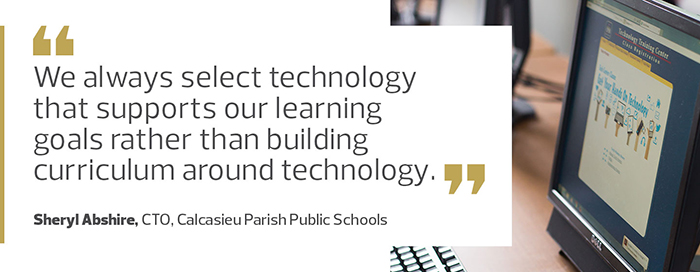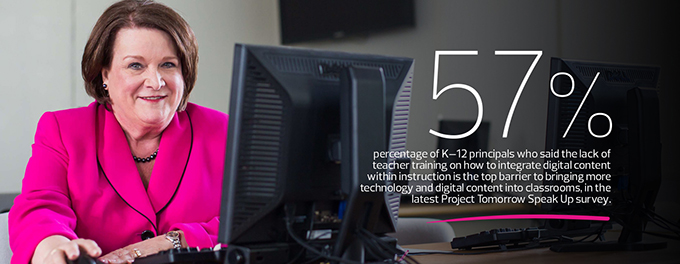Technology Starts with Professional Development and Training
Calcasieu Parish Public Schools in Lake Charles, La., has been using technology in its classrooms for three decades. Two basic lessons have emerged from that long experience: support and training.
“We always select technology that supports our learning goals rather than building curriculum around technology,” says CTO Sheryl Abshire, whose district serves 32,600 students with 2,600 teachers in 64 schools and alternative learning sites. “And we don’t put any technology in classrooms without first giving hands-on training for teachers.”
But that’s not all the district has learned. CPPS, the fifth-largest school district in the state, has a multifaceted professional development strategy that goes far beyond training for specific tools, creating a culture in which teachers embrace technology as an essential support for their work, says Abshire. The district built a technology training center, where teachers learn how to use new tools but also regularly receive coaching on how technology can enhance their curricula. Technology facilitators provide continuing support for teachers in their classrooms.
CPPS also offers online courses and a host of summer classes for teachers on topics such as how to get the most out of tablets, Promethean content and Blackboard, the district’s learning management system (LMS). A comprehensive suite of webinars gives teachers the freedom to pursue professional development at their convenience.
As added incentive, teachers earn “tech points” for PD hours accrued, and can redeem accumulated points for extra classroom technology.
“We’ve built a community that inspires confidence and willingness to take risks around technology,” Abshire says. “The result is that we get the effective use of technology across the district, not just in pockets. Teachers have come to expect that technology implementations will succeed in their classrooms.”
PD efforts around technology should start by asking teachers what they need and focusing on those issues first, says Abshire. Administrators and school technologists should also investigate what’s working in other districts.
“Nobody in the process should be afraid to ask for help and advice,” she says. “For teachers, especially, I say, don’t be disenchanted or disenfranchised. You will learn how to use these tools to make your work easier and better.”

How’s Are the Changes Working?
Districts such as Calcasieu Parish are the standouts in a wildly varied landscape of technology training for K–12 teachers, says Alex Inman, the founder of Educational Collaborators, a firm that offers PD consulting services to schools across the U.S. and internationally.
“The schools that do it well tie professional development around technology into a larger framework of learning goals and the mission of the school,” says Inman. “They’re looking for growth over time as technology is integrated into the classroom. They don’t look at it short-term, even if they’re training for a specific tool.”
Follow-up is critical for every PD effort, Inman says. Districts should gather all the data and anecdotal information they can during the session to see how the strategy is working, both in terms of technology training for teachers and its impact on learning in the classroom.
“You can modify professional development as you go along, but you need to know what your successes are and where you’re falling short,” he says. “Big technology initiatives are complicated, so it’s not a surprise that it’s complicated for your staff to learn to make the most of them.”
Learn How Adults Learn
Research into how adults learn and what motivates them to welcome new ideas and the acquisition of new skills is essential to providing effective PD, says Andrew Smith, director of Digital Innovation at the Rowan-Salisbury School System in Salisbury, N.C. R-SSS enrolls about 20,000 students in 35 schools and has 3,000 staff members.
“Effective professional development is not something that’s typically taught in educational administration classes, and it’s a real issue,” says Smith. “Teachers justifiably wonder how they have time to learn something new when they’re already asked to do so much. In North Carolina, we don’t have the money to pay people for professional development time, so we have to get really creative in the way we do things in order to get people excited.”
Rowan-Salisbury relies heavily on “job-embedded” professional development delivered by instructional technology specialists in each school, who provide training and support specifically tailored to the needs of individual teachers, Smith says. In addition, conferences sponsored by the district address topics that teachers have requested and give them a chance to share their expertise in the use of learning technologies. The district sends principals and teachers to national conferences so that they can grasp what other educators are accomplishing with learning technologies. Rowan-Salisbury’s Center for Innovation will open in a few months, conceived as a hub of PD and a makerspace for teachers to “play” with new ideas and new technologies, Smith says.
Money and time for PD are in short supply in most school districts, Smith notes, but investments in both are necessary to create a professional learning community around technology.
“You have to schedule PD during the school day, not tell teachers to go learn it on your own and on your own time,” he says. “Districts have to commit to funding instructional technology facilitators to give teachers the support they need to use technology well.”
Technology Requires Trainers
Instructional technology specialists are the core of the professional development plan at Forsyth County Schools in Cumming, Ga., 40 miles north of Atlanta. “If you’re going to use technology in your classrooms, make sure you have the people to carry out the training,” says Coordinator of Instructional Technology Jill Earman, whose district has about 5,000 teachers and staff serving almost 45,000 students. “We would not be where we are with technology integration without the 50 people dedicated to teaching people to use the technology.”
Teachers have to be proficient in using the district’s LMS, itslearning, which has become central to the way the district operates — there are not even days off for bad weather in Forsyth County, as lessons are delivered to homebound students through the LMS. An instructional technology team travels among the district’s 35 schools, providing training focused on, but not limited to, the LMS. Each school also has a dedicated technology specialist (some high schools have two) who rotates through classrooms, co-teaching and modeling ways that technology can be used to support and extend the curriculum, Earman says.
The LMS also is there to serve the learning needs of teachers, who can access recordings of some of the professional development sessions offered by the district as well as an extensive collection of training webinars through itsLearning, she says.
“We have to offer ways for teachers to get the training they need when they need it,” Earman says. “That’s the just-in-time support the ITSes offer. There has to be respect for all that teachers have to do, and there has to be follow-up to make sure they’re not struggling with new skills. The old ‘sit-and-get,’ one-time event model of professional development doesn’t work."









